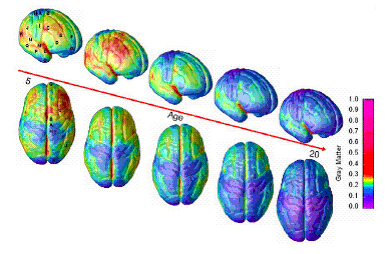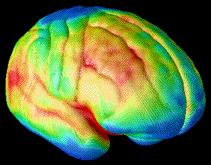THE ADOLESCENT BRAIN -- WHY TEENAGERS THINK AND ACT DIFFERENTLY--
It now appears some of that baffling behavior of your teenage child (or student) may be the result of neurobiology not raging hormones
For many years it was thought that brain development was set at a fairly early age. By the time teen years were reached the brain was thought to be largely finished. However, scientists doing cutting-edge research using magnetic resonance imaging, or MRI, have mapped the brain from early childhood into adulthood and found data contrary to these beliefs. It now appears the brain continues to change into the early 20's with the frontal lobes, responsible for reasoning and problem solving, developing last.
The decade-long magnetic resonance imaging (MRI) study of normal brain development, from ages 4 to 21, by researchers at NIH's National Institute of Mental Health (NIMH) and University of California Los Angeles (UCLA) shows that such "higher-order" brain centers, such as the prefrontal cortex, don't fully develop until young adulthood as grey matter wanes in a back-to-front wave as the brain matures and neural connections are pruned. (see figure 1).

Figure 1.
Time-Lapse Imaging Tracks Brain Maturation from ages 5 to 20
Constructed from MRI scans of healthy children and teens, the time-lapse "movie", from which the above images were extracted, compresses 15 years of brain development (ages 5–20) into just a few seconds.
Red indicates more gray matter, blue less gray matter. Gray matter wanes in a back-to-front wave as the brain matures and neural connections are pruned.
Source: Paul Thompson, Ph.D. UCLA Laboratory of Neuroimaging
http://www.nimh.nih.gov/press/prbrainmaturing.cfm?styleN=one
In calm situations, teenagers can rationalize almost as well as adults. But stress can hijack what Ron Dahl, a pediatrician and child psychiatric researcher at the University of Pittsburgh Medical Center calls "hot cognition" and decision-making. The frontal lobes help put the brakes on a desire for thrills and taking risk -- a building block of adolescence; but, they're also one of the last areas of the brain to develop fully.
Although scientists don't know yet what accounts for the observed changes, they may parallel a pruning process that occurs early in life that appears to follow the principle of "use-it-or-lose-it:" neural connections, or synapses, that get exercised are retained, while those that don't are lost.
In calm situations, teenagers can rationalize almost as well as adults. But stress can hijack what Ron Dahl, a pediatrician and child psychiatric researcher at the University of Pittsburgh Medical Center calls "hot cognition" and decision-making. The frontal lobes help put the brakes on a desire for thrills and taking risk -- a building block of adolescence; but, they're also one of the last areas of the brain to develop fully.
Although scientists don't know yet what accounts for the observed changes, they may parallel a pruning process that occurs early in life that appears to follow the principle of "use-it-or-lose-it:" neural connections, or synapses, that get exercised are retained, while those that don't are lost.
Brain Tissue Changes in Development (15 year timespan) Time-lapse Imaging Tracks Brain Developing from ages 5 to 20 NIMH/UCLA Project Visualizes Maturing Brain Source: Paul Thompson, Ph.D. UCLA Laboratory of Neuroimaging |
|
"The most surprising thing has been how much the teen brain is changing. By age six, the brain is already 95 percent of its adult size. But the gray matter, or thinking part of the brain, continues to thicken throughout childhood as the brain cells get extra connections, much like a tree growing extra branches, twigs and roots... ...In the frontal part of the brain, the part of the brain involved in judgment, organization, planning, strategizing -- those very skills that teens get better and better at -- this process of thickening of the gray matter peaks at about age 11 in girls and age 12 in boys, roughly about the same time as puberty. After that peak, the gray matter thins as the excess connections are eliminated or pruned... ...But the pruning-down phase is perhaps even more interesting, because our leading hypothesis for that is the "use it or lose it" principle. Those cells and connections that are used will survive and flourish. Those cells and connections that are not used will wither and die. So if a teen is doing music or sports or academics, those are the cells and connections that will be hard-wired. If they're lying on the couch or playing video games or MTV, those are the cells and connections that are going [to] survive... ...Right around the time of puberty and on into the adult years is a particularly critical time for the brain sculpting to take place... ... It;s sort of unfair to expect teens to have adult levels of organizational skills or decision-making before their brains are finished being built... ...The frontal lobe is often called the CEO, or the executive of the brain. It's involved in things like planning and strategizing and organizing, initiating attention and stopping and starting and shifting attention. It's a part of the brain that most separates man from beast, if you will... ...I think that [in the teen years, this] part of the brain that is helping organization, planning and strategizing is not done being built yet ... [It's] not that the teens are stupid or incapable of [things]. It's sort of unfair to expect them to have adult levels of organizational skills or decision making before their brain is finished being built. ... ...doing drugs or alcohol that evening, it may not just be affecting their brains for that night or even for that weekend, but for the next 80 years of their life..."
|
Excerpts from an interview with Jay Giedd: Jay Giedd, M.D. is a practicing Child and Adolescent Psychiatrist and Chief of Brain Imaging at the Child Psychiatry Branch of the National Institute of Mental Health For full interview see: Inside the Teenage Brain |
IMPLICATIONS OF STUDIES
One goal is to learn what teachers can do to take advantage of the time when their students' brains change the most. If some parts of the brain develop sooner than others, for example, perhaps school subjects should be taught in a different order.
Teenagers are four times as likely as older drivers to be involved in a crash and three times as likely to die in one, according to the Insurance Institute for Highway Safety. "Right now our first subjects are reaching driving age," Giedd said. "What better application could there be than saving their lives?"
Knowing what their brains are going through might also motivate teenagers to change their own priorities. "What you do with your brain during that time," Giedd says, "could have a lot of good and bad implications for the rest of your life."
Eventually, brain studies might help resolve conflicts at home. Teenagers are capable of learning a lot, but the parts of their brains related to emotions and decision-making are still in the works. As their brains undergo rewiring, teenagers are particularly vulnerable to risky behavior, such as drinking and driving too fast.
Brain immaturity can explain why the teen crash rate is so high.
RECENT UPDATES
A recent study by Lebel and Beaulieu (see below) reinforce the above findings that the human brain doesn't stop developing at adolescence, but continues well into our 20s. The study is the first long-range investigation, using a type of imaging that looks at brain wiring and shows that in the white matter there are still structural changes happening during young adulthood. The white matter connects different regions to facilitate cognitive abilities. The study suggests that connections are strengthening even as we age in young adulthood.
C. Lebel, C. Beaulieu. Longitudinal Development of Human Brain Wiring Continues from Childhood into Adulthood. Journal of Neuroscience, 2011.
| Abstract: Healthy human brain development is a complex process that continues during childhood and adolescence, as demonstrated by many cross-sectional and several longitudinal studies. However, whether these changes end in adolescence is not clear. We examined longitudinal white matter maturation using diffusion tensor tractography in 103 healthy subjects aged 5–32 years; each volunteer was scanned at least twice, with 221 total scans. Fractional anisotropy (FA) and mean diffusivity (MD), parameters indicative of factors including myelination and axon density, were assessed in 10 major white matter tracts. All tracts showed significant nonlinear development trajectories for FA and MD. Significant within-subject changes occurred in the vast majority of children and early adolescents, and these changes were mostly complete by late adolescence for projection and commissural tracts. However, association tracts demonstrated postadolescent within-subject maturation of both FA and MD. Diffusion parameter changes were due primarily to decreasing perpendicular diffusivity, although increasing parallel diffusivity contributed to the prolonged increases of FA in association tracts. Volume increased significantly with age for most tracts, and longitudinal measures also demonstrated postadolescent volume increases in several association tracts. As volume increases were not directly associated with either elevated FA or reduced MD between scans, the observed diffusion parameter changes likely reflect microstructural maturation of brain white matter tracts rather than just gross anatomy. |
Edinformatics News Feeds
- Science (General)
- Science Specific
- Health and Medicine
- Cancer EurekAlert
- Infectious and Emerging Diseases
- Environmental and Atmospheric Sciences
- Mathematics News
- Food and Nutrition
- Chemistry and Physics News
- Nanotechnology News
- NASA Universe
- Space and Planetary News
- Science Education
- Business and Stocks
- Global News
- Culinary News
- New York Times Book Review
- Education Week News
- Entertainment News
- Sports News
- Science News for Kids

